
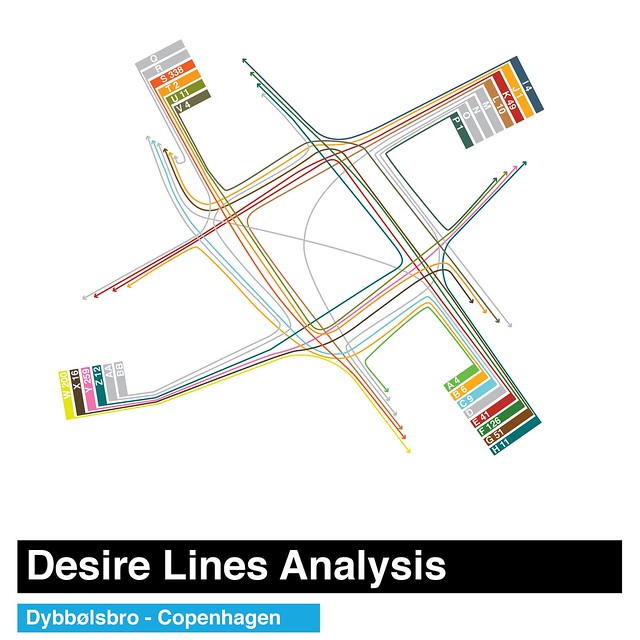 Mikael, on behalf of Copenhagenize Design Co., is a teacher in the Bicycle Urbanism Studio led by urban liveability expert Bianca Hermansen at the Danish Institute for Study Abroad (DIS). Since 1959, DIS has given American students the chance to study in Denmark. Our Bicycle Urbanism Studio features American architecture students.
Mikael, on behalf of Copenhagenize Design Co., is a teacher in the Bicycle Urbanism Studio led by urban liveability expert Bianca Hermansen at the Danish Institute for Study Abroad (DIS). Since 1959, DIS has given American students the chance to study in Denmark. Our Bicycle Urbanism Studio features American architecture students.
Mikael led a portion of the course involving a massive Desire Lines analysis of two intersections at either end of the Dybbøls Bridge in the Vesterbro neighbourhood, where the coming elevated cycle track - "Bicycle Snake – Cykelslangen" - will be connected. Here's a map of the area in question.
Working with the students - Anna Darling, David Mitchell, Jeannette Mundy, Elaine Stokes, Michelle Woods, Michelle Zucker, Ben Zünkeler - was brilliant and inspiring. Here is a summary of their studies.
You can download here the full report of the Dybbølsbro's Desire Lines analysis.
Meant as a companion document to “Desire: The Bicycle Choreography of anUrban Intersection” the following study chronicle the usage of two intersections straddling the Dybbølsbro S-Tog station over the course of a 13 hour period. In order to determine how daily cyclists would react to the implementation of the proposed “Cycle Snake,” cyclist patterns were documented. Through the analysis of types of movement and frequented Desire Lines, a data based indication of the usage of the new infrastructure and a verifiable hypothesis of potential points of conflict can be developed.
As Jane Jacobs noted “There is no logic that can be superimposed on the city; people make it, and it is to them […], that we must fit our plans.” We must be aware that despite best intentions, building without reference to the patterns of people can result in conflicts and failures that could have been foreseen and prevented. Through careful consideration of the data design solutions have been developed that strive to enhance the “cycle snake” proposal while remaining conscious of the realities of human behavior.
The observations are meant to reveal, inform, and inspire.
Bicycle Infrastructure Implementation Through Observation
Our focus is to determine how many people, currently, use the stairs to get to their final destination and if a solution can be presented that will better accommodate the needs of cyclists than the new “snake” infrastructure.
Our goal is also to use fact-based information to make decisions in our designs. The new layout should accommodate not only those who correctly follow the rules of the road but also those who feel the need to break the rules in order to get where they need to go more quickly. Both provide important evidence of human behavior.
4.756 - This number represents the total amount of people who use the staircase on a daily basis. We can assume that at least this number of people will use the new “snake” infrastructure when it is installed.
92% - Ninety-two percent of cyclists coming up the staircase head in the direction of Dybbølsbro station. This means the majority of people who use the stairs are doing so to get somewhere other than the mall.
37% - Looking closely at the mall intersection, we noticed that thirty-seven percent of all travelers heading southeast used the stairs to get to their future destination. This figure takes into consideration those going against the flow of traffic, those cycling in pedestrian crossings and those who abode by the rules.
Fisketorvet intersection: 7.059 Cyclists (from 7am to 8pm)
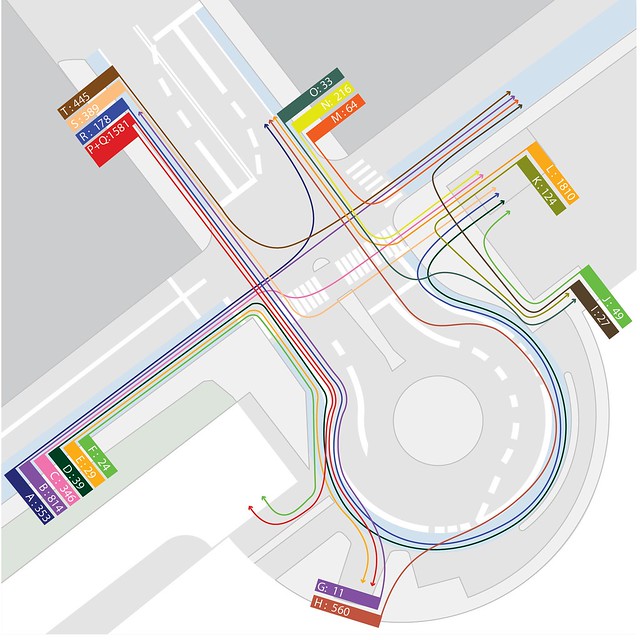
During the morning rush hour, Fisketorvet is the destination for very few cyclists. Instead, the intersection is used primarily by commuters going up or down the stairs descending from the northeast corner of the intersection. As a result, the northeast corner frequently backs up with bikers. Additionally, the low level of car traffic at this hour gives the cyclists more freedom to bend the rules as they move through the intersection.
Midday routes demonstrate a significant increase of cyclists entering or exiting the mall. During the mall’s opening hours, there was a relatively steady increase of pedestrians, cyclists, and cars alike entering the round-about.
Morning Rush Hour, 8:45-9:00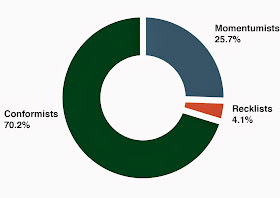
.jpg)
During the peak of morning rush hour outside the Fisketorvet, a significantly higher percentage of cyclists bent or broke the rules compared to a standard Copenhagen intersection. In “The Bicycle Choreography of an Urban Intersection,” it was found that on an average day at a standard intersection, 93% of cyclists conformed to traffic laws, while 6% could be qualified as Monumentalists and 1% could be qualified as Recklists. The large increase of Monumentalists at this intersection can be accounted for by the number of people taking a left turn as if they were a car and cutting across traffic rather than doing the standard “Copenhagen left.” This data makes it clear that the high flow of commuters are in need of a more direct route crossing this intersection coming to and from the future Snake structure.
Midday, 12:00-12:15
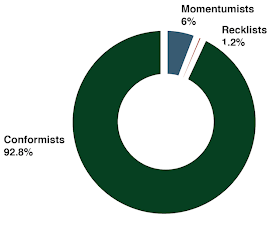 During the middle of the day at the Fisketorvet Mall intersection, a standard distribution of Momentumists and Recklists can be observed as in accordance with the data gathered in “The Bicycle Choreography of an Urban Intersection”. When comparing the data collected from this intersection at midday with the data from the morning and afternoon, which showed higher percentages of rule bending, the conformists behavior can be attributed to higher volumes of vehicular traffic and less bicycle traffic. With more vehicles on the road as compared to the other observed times, bicyclists need to be more cautious. There are also not as many bikers on the road, so a pack mentality is not often created.
During the middle of the day at the Fisketorvet Mall intersection, a standard distribution of Momentumists and Recklists can be observed as in accordance with the data gathered in “The Bicycle Choreography of an Urban Intersection”. When comparing the data collected from this intersection at midday with the data from the morning and afternoon, which showed higher percentages of rule bending, the conformists behavior can be attributed to higher volumes of vehicular traffic and less bicycle traffic. With more vehicles on the road as compared to the other observed times, bicyclists need to be more cautious. There are also not as many bikers on the road, so a pack mentality is not often created. 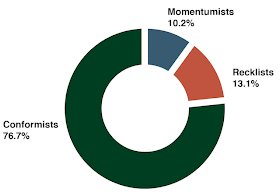 Evening Rush Hour, 6:00 - 6:15
Evening Rush Hour, 6:00 - 6:15During the peak of evening rush hour outside the Fisketorvet, a significantly higher percentage of cyclist bent or broke the rules compared to a standard Copenhagen intersection. The large increase of Recklists at this intersection can be accounted for by the number of people exiting the staircase and entering traffic. Cyclists behavior is largely dependent on the pedestrians moving through the plaza where the future construction of the snake is to take place. This data makes it clear that the high number of recklists commuters need proper infrastructure to navigate the plaza and eliminate this type of behavior.
Ingerslevsgade Intersection
Morning Rush Hour
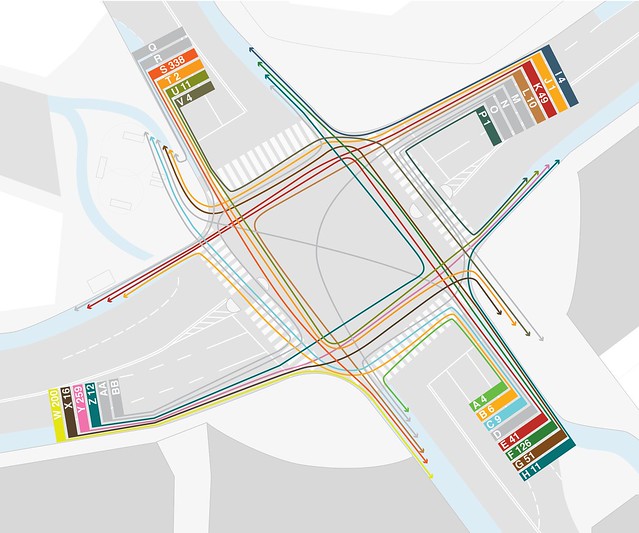
Morning Rush Hour, 8:45-9:00

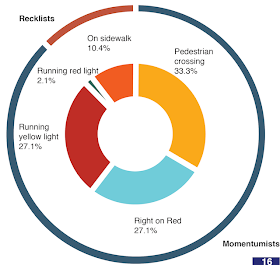 The Ingersevgade operates as a fairly standard Copenhagen intersection: two intersecting roads with traffic lights on all corners. Still, this intersection has approximately twice as many momentumists and reckists as the streets studied in “The Bicycle Choreography of an Urban Intersection.” The breakdown of types of deviations reveals that flexible interpretations of light signals and use of the pedestrian crossing accounts for these increases. After considering the time of day and unique site features, it is reasonable to assume that cyclists hurrying to work are less willing to wait at red land yellow lights. Additionally, the majority of cyclists using the pedestrian crossing were moving between the S-Tog corner and the neighborhood corner (Southeast and Northwest).
The Ingersevgade operates as a fairly standard Copenhagen intersection: two intersecting roads with traffic lights on all corners. Still, this intersection has approximately twice as many momentumists and reckists as the streets studied in “The Bicycle Choreography of an Urban Intersection.” The breakdown of types of deviations reveals that flexible interpretations of light signals and use of the pedestrian crossing accounts for these increases. After considering the time of day and unique site features, it is reasonable to assume that cyclists hurrying to work are less willing to wait at red land yellow lights. Additionally, the majority of cyclists using the pedestrian crossing were moving between the S-Tog corner and the neighborhood corner (Southeast and Northwest). 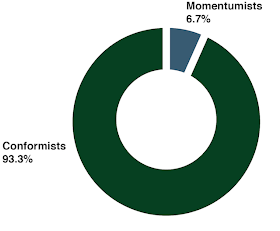 During the middle of the day, the Dybbølsbro intersection functioned as a standard Copenhagen intersection as reported in “The Bicycle Choreography of an Urban Intersection”. It was found that on an average day at a standard intersection, 93% of cyclists conformed to traffic laws, while 6% could be qualified as Monumentalists and 1% could be qualified as Recklists. The data at this intersection matches and supports this data. The Dybbølsbro intersection is a fairly typical intersection, with the exception of a good amount of bicycle traffic coming into and from the intersection through an adjoining neighborhood road. The high percentage of bikers using pedestrian crossings to cross the street were mainly people using this street.
During the middle of the day, the Dybbølsbro intersection functioned as a standard Copenhagen intersection as reported in “The Bicycle Choreography of an Urban Intersection”. It was found that on an average day at a standard intersection, 93% of cyclists conformed to traffic laws, while 6% could be qualified as Monumentalists and 1% could be qualified as Recklists. The data at this intersection matches and supports this data. The Dybbølsbro intersection is a fairly typical intersection, with the exception of a good amount of bicycle traffic coming into and from the intersection through an adjoining neighborhood road. The high percentage of bikers using pedestrian crossings to cross the street were mainly people using this street.
Evening Rush Hour, 6:00 – 6:15
 During the peak of evening rush hour outside the Fisketorvet, a significantly higher percentage of cyclist bent or broke the rules compared to a standard Copenhagen intersection. The large increase of Monumentalists at this intersection can be accounted for by the number of people entering the pedestrian crossings and creating conflict with pedestrians moving through the intersection. The high percentage of cyclists on the sidewalk can be attributed to an overflow accumulation of cyclists on street corners while waiting for the green light.
During the peak of evening rush hour outside the Fisketorvet, a significantly higher percentage of cyclist bent or broke the rules compared to a standard Copenhagen intersection. The large increase of Monumentalists at this intersection can be accounted for by the number of people entering the pedestrian crossings and creating conflict with pedestrians moving through the intersection. The high percentage of cyclists on the sidewalk can be attributed to an overflow accumulation of cyclists on street corners while waiting for the green light. This is likely the reason for cyclists running yellow and red lights to avoid waiting amongst large crowds. This data makes it clear that the high flow of commuters are in need of a more direct route crossing at this intersection coming to and from the future Snake structure.
Copenhagenize Fixes
Fisketorvet Intersection
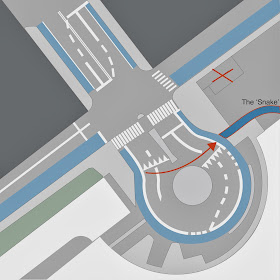
In a few months, instead of carrying their bikes up the stairs, the bicycle users will use the elevated cycle track designed specifically for them. But what about the connection between this much-needed infrastructure and the cycle tracks on the road? The bicycle users will arrive on a roundabout designed for the cars, and so the creation of this new infrastructure calls for a rearrangement. We can assume that in the future, bicycle users coming from the bridge and heading to the “Snake” will cut across the roundabout in front of Fisketorvet shopping mall. Indeed, currently we notice that only 23% (lines D and R vs lines C and S) of the bicycle users heading to the stairs cycle all the way around the roundabout. The other ones use the pedestrian crosswalk. That's why we suggest creating an official blue bike lane reaching the ‘Snake’ and to add two yield lines for the cars. This solution is the one that causes the least amount of changes to the current layout.
Ingerslevsgade Intersection
The Desire Lines analysis shows that most bicycle users cross the intersection normally, or use the crosswalks. The main aspect that does not meet the cyclists' needs is the new bike lanes on the sidewalk designed to reach Dybbølsgade. It is actually a good idea to make this small section of bike route 'official', since it is a well-known short-cut through Vesterbro. But the design of the lanes does not follow the natural trajectories of the cyclists. This infrastructure was brand-new when the study was made and we noticed that all the bicycle users took the lane in the wrong way. A few months later, less bicycle users made this ‘mistake’ but still a massive number of them cycle on the sidewalk without following the lane. Instead they take, as one might expect, the shortest way to reach their destination. Here again, our proposal is the one that causes the least amount of rearrangement. Opening the street in the middle instead of on the edges - where the bicycle users must snake around fences - would have been the best solution.




